Last week, when I shared my first impressions from the my three-week trip in Russia, I promised to publish a separate post to delve into further detail about my reflections from the Trans-Siberian Railway.
In due course, I will of course write detailed reviews of each leg of the 12-day journey between Moscow and Beijing. For now, I offer you a loosely organized collection of the various meditations that passed through my mind as I hurtled across the vast Eurasian continent. These include reflections about the nature of the trip itself, things that I found striking along the way, and new perspectives on travel and what it means to be a traveller that I’ve gained as a result of making the trip along this particular route.
It’s my hope that by jotting down my immediate thoughts and reflections while they’re still fresh in my mind, I’ll be able to provide an authentic window into what it’s like to travel along the Trans-Siberian Railway, and hopefully inspire those of you with aspirations of conquering the world’s longest train journey to take action and make your plans a reality someday.
The Journey East Begins
It’s a rainy night in Moscow, and we’re all huddled in a fast-food joint just outside of Yaroslavksy Station. Russia is facing Croatia in the World Cup quarterfinals, and the entire nation is on the edge of its seat.
At around 10:30pm, we’re forced to abandon the enthralling spectacle and board our train, with the score deadlocked at 1-1. By some twist of fate, we’re travelling in Third Class on this brief overnight ride to Nizhny Novgorod, before catching our 41-hour First Class train to Novosibirsk. Call it a baptism of fire – we found ourselves next to a kind middle-aged lady, a mother and daughter travelling together, and a drunkard who smelled like he hadn’t showered in days!
The daughter speaks English, and we get to chatting. She was just finishing up a school trip in Europe and was heading home. We explain that we’re taking the train all the way to Beijing, and she thinks we are “kind of crazy, but cool!” Later on, after we’ve all experienced the rollercoaster of emotions of using a stuttering 3G stream to watch Russia score a late goal before losing on penalties, we exchange Instagram handles to keep in touch.
Friendly Encounters
It would become one of the themes of the trip. Whenever we interacted with locals, they were exceedingly pleasant, approachable, and above all, curious about what these foreigners who stuck out like a sore thumb were doing in their country.
We changed trains in Nizhny Novgorod between 4:50am and 5:50am. During this time, a clearly inebriated Russian young man started chatting to us, entirely unprovoked. Even when it became clear that our conversation would be slow and painstaking, he insisted that we use Google Translate to get our ideas across. Eventually, we learned that he was on his way to Semyonov, a neighbouring town, and he learned of our Trans-Siberian plans. “Horosho!” he said repeatedly – “Good!”
Settling In
We get a good look at our home for the next 41 hours or so: the famous Rossiya train, whose entire route runs from Moscow all the way to Vladivostok on Russia’s Pacific coast. The striking red RZD lettering emblazoned across the body of the train cars would come to be a familiar sight.
The train gets going right on time. We proceed to draw the shades and catch up on sleep, waking up at about noon. And just like that, seven hours of the 41 had passed.

Trans-Siberian Railway, First Class
The Conditions
Let’s be real. The bathroom situation is about what you’d expect for a moving train. It’s not the height of luxury, but it also isn’t worse than your average public bathroom on the ground either. There’s a toilet and a washbasin, and any stray water flows directly down onto the open tracks below.
You get used to the conditions and the time just passes. Incredibly, my body seemed to know that the conditions weren’t optimal for “doing a #2”, and I completed three of the four individual train journeys having “held it in” successfully.
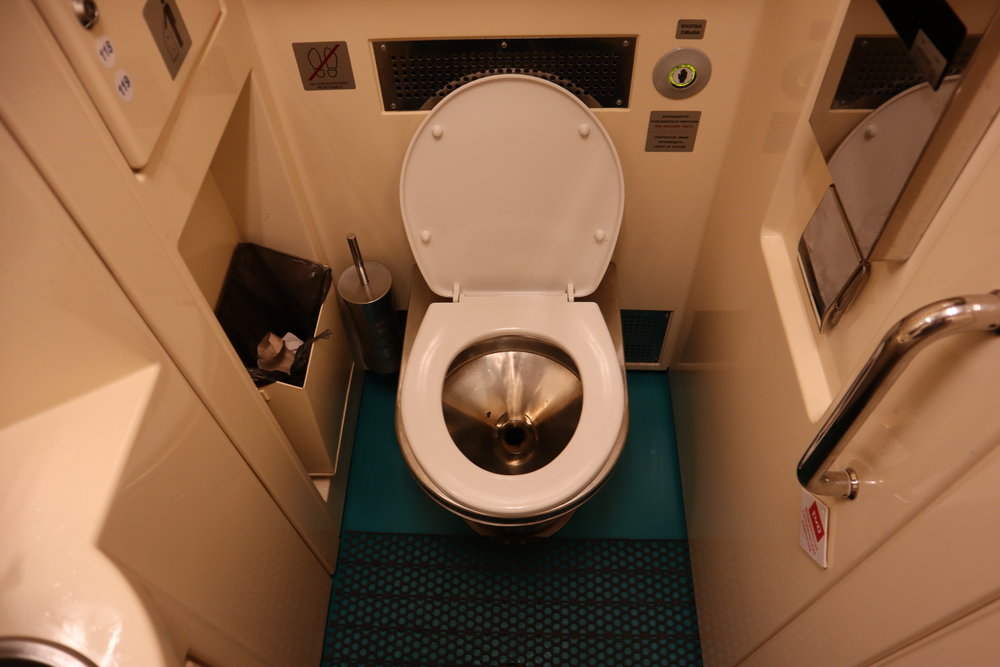
Bathrooms on the Trans-Siberian Railway
Pit Stops
We get off for some fresh air at various stops along the way. These places you’ve likely never heard of, unless you’re like me and enjoy spending hours trawling through Wikitravel on a slow day. Tyumen, Omsk, Krasnoyarsk, Ulan-Ude. These aren’t small places – after all, they’re still major cities with hundreds of thousands of inhabitants – they just happen to be far-removed from the global consciousness.
Then there were the pit stops that were actually tiny. Balezino, Barabinsk, Ilanskaya, Nizhneudinsk. Specks on the map with sparse populations, their only claim to fame being their position along the world’s most important rail link.
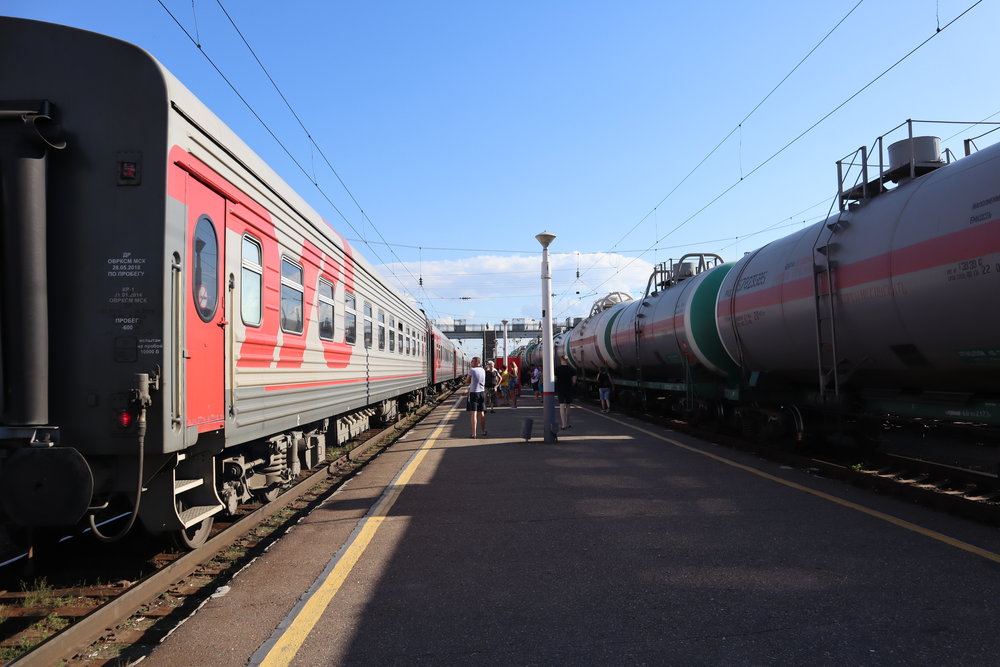
Balezino, Udmurtia, Russia
I spend a lot of time thinking about what it means to go somewhere and be somewhere, and it’s something I think a lot of travellers can relate to. Take Balezino, for example, the eighth-largest settlement within the Republic of Udmurtia, one of Russia’s republics. About 35,000 people live here. I stood for a while on the pedestrian footbridge at the train station, looking at the station building and the city centre beyond.
At that moment, I had both “set foot” and “laid eyes” on Balezino, to borrow a few travellers’ catchphrases. But what can I really say about it? Did I take the time to understand the place, its characteristics, and the lives of its citizens? No, I hopped back on the train and continued on my merry way.
I’m spending time in Novosibirsk, Irkutsk, and Ulaanbaatar this time around. But what about Balezino and the other places I’ve “missed out on” along the way? Should I come back for them next time? Just because a place is relatively insignificant, does that make it inherently less worth visiting?
These thoughts plague my mind as the rumble of the train carries me off to sleep that night. I don’t have any good answers.
Haute Cuisine
Instant noodles are the order of the day when you’re travelling by train. Since you have access to hot water, they’re the most logical thing to eat, and by the end we were pretty much running out of flavours to try.
You’ll also have the opportunity to buy food from kiosks during the pit stops. Overall, instead of eating three meals a day, we mostly ate snacks at odd hours to keep ourselves full. You’re not really exerting much energy, so you tend not to be too hungry anyway.
On the First Class portion of our trip, we were treated to a complimentary meal in the restaurant car. Soup, chicken sausage, and mashed potatoes. About as good as it gets!

Dinner in the restaurant car
Jet Lag
Or rather, the lack of it. Train travel is kind of interesting when it comes to adjusting between time zones, since you’re basically meandering through each time zone one-by-one. After all, Novosibirsk is four hours ahead of Moscow, so as you’re travelling eastbound, you suddenly “lose” an hour at seemingly random intervals as you cross from UTC+3 to UTC+4, UTC+5, etc.
Accordingly, once you get off the train, your body doesn’t “feel” like it has jet lag (since the sensation is so often associated with air travel), but it does. And furthermore, it felt strange to arrive in Beijing at the end and not have jet lag, since I almost always arrive home by plane, whereas this time I had already spent several days acclimating to the UTC+8 time zone.
Hello, Siberia!
There’s a good chance you’ve never heard of Novosibirsk, but it’s in fact Russia’s third-largest city. It has wide avenues, beautiful churches, and a large zoo that’s apparently world-renowned for its conservation efforts.
We spend a few days exploring the city and seeing virtually everything there is to see. I even go for a haircut at the local barber shop, chatting with my hairstylist about his dreams of hitchhiking down to Chita on the Mongolian border.
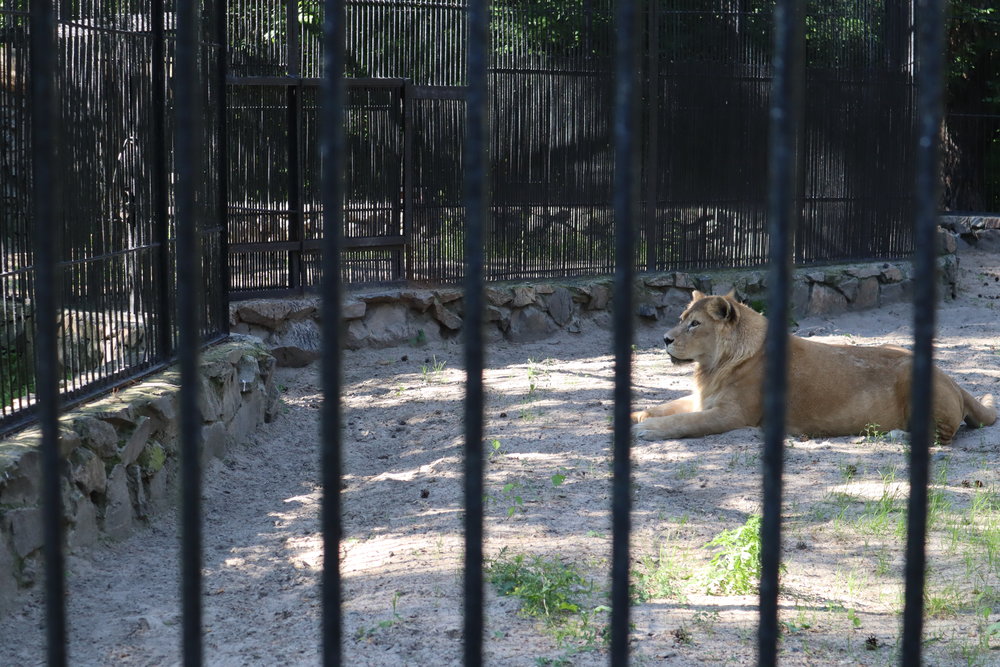
Novosibirsk Zoo
As we venture into Siberia and beyond, I find it striking how little we know about Russia here in the West, and yet we spend so much energy denouncing them in our endless “us vs. them” narratives. It must be a confusing time for the Russian people as well, to be cast as the villains of the world despite simply being ordinary people just like you and me. One of the motivations of this trip was to see Russia with my own eyes and break down my pre-conceived notions, and I’m grateful to have had the opportunity to do exactly that.
Life of a Third Class Citizen
Back on the train. This time, we were in Third Class on the way to Irkutsk. As you’d expect, the cabin smells like body odour, but your nose gets used to it after a while, and you only notice it once you get off for fresh air and come back on. Meanwhile, crumpled sheets are all over the place, feet are dangling from the upper berths, and the scent of instant noodles is permanently wafting throughout.
Third Class has all the ingredients to be absolute chaos, but surprisingly it wasn’t. People get on and off the train at different times, so they’ll be sleeping at odd hours. Passengers travelling in groups typically chat quietly for each other. Lots of passengers simply sit idly and do nothing, staring into space like non-player characters from a video game. It’s kind of odd to look at.
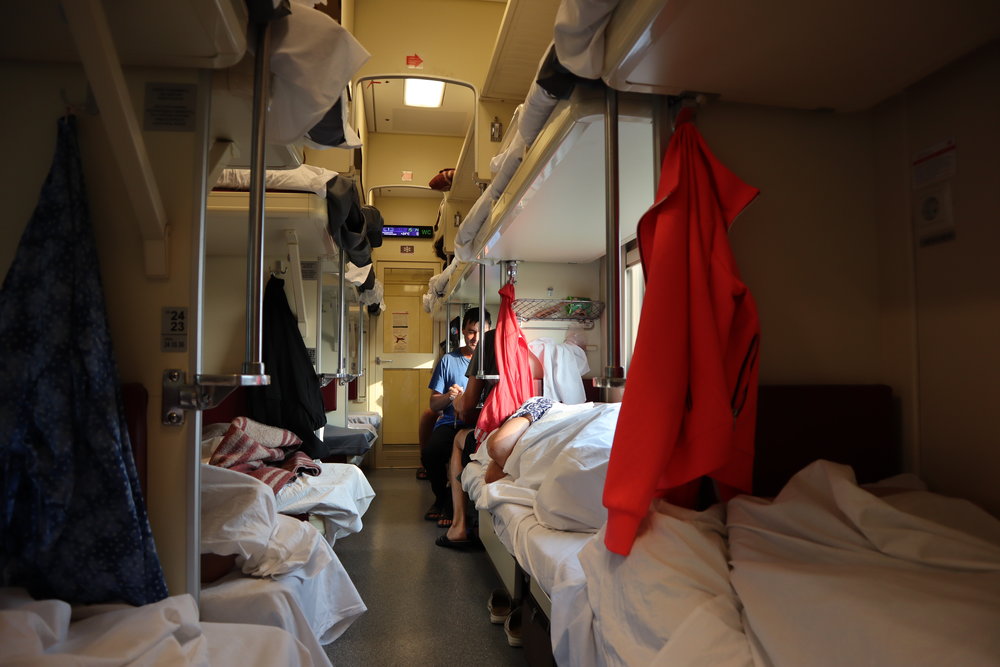
Trans-Siberian Railway, Third Class
We spend most of our time watching Netflix shows, reading books, and eating snacks. We’ve brought along a game of pocket battleship as well, which helps to pass the time. As we drift off to sleep, Jessica and I chat about our hopes and dreams – one of those things you simply must do on a long train journey – and it’s at this point that I realize that one of the ambitions on my list would’ve been to take the Trans-Siberian Railway, and that I was in fact fulfilling that dream right now.
The bathroom situation here is virtually identical to First Class, with one important difference: the smell is absolutely horrendous. It makes you wish the journey would end soon.
“Train Daze”
After a few days on the train, I fell into what I called a “train daze”. The endless rumble along the train tracks was sort of hypnotizing – ba-dum-ba-dum, ba-dum-ba-dum – and made me feel inclined to just sit around and let time go by, rather than do anything of real value.
To keep ourselves sane, we made conversation with our fellow travellers. There were a British couple and two Chinese guys who were doing virtually the same route as us, as well as a Turk who planned to complete the 7-day continuous train journey to Vladivostok and then take the ferry to South Korea. Bring a pack of cards and some snacks for sharing, and you’re guaranteed to meet some interesting folks – after all, you need to be “crazy” enough to attempt this in the first place!
An Odd Time in Mongolia
I’ll be honest – while I successfully challenged my pre-conceived notions of Russia, I’ve still got work to do when it comes to Mongolia.
Foreigners tend to have a great time visiting Mongolia, seeing its vast deserts and countryside, and admiring the nomadic lifestyle of its peoples. But as a Mandarin-speaking Chinese person in Ulaanbaatar, all I experienced was the cognitive dissonance of seeing Mongolian people who looked almost exactly like me, but didn’t speak a lick of the same language. It was frankly quite a jarring experience.
I’d love to return to the country someday to get out of the city and do a proper tour of the Gobi Desert, but my experience this time around was soured by a torrential downpour that turned Ulaanbaatar’s roads into rivers (the city’s storm drains are virtually non-existent). We were also feeling pretty burnt out by this stage of the trip, which definitely contributed to our overall irritability during our time here.
Credit where it’s due, though – the Mongolian trains are superb and are really a class above the Russian trains. If you’re interested in dabbling with train travel but don’t have time for the full Trans-Siberian or Trans-Mongolian itinerary (or you don’t want to deal with the hassle of obtaining a Russian visa), I’d highly recommend just taking the train between Ulaanbaatar and Beijing on Mongolian trains #23 or #24.
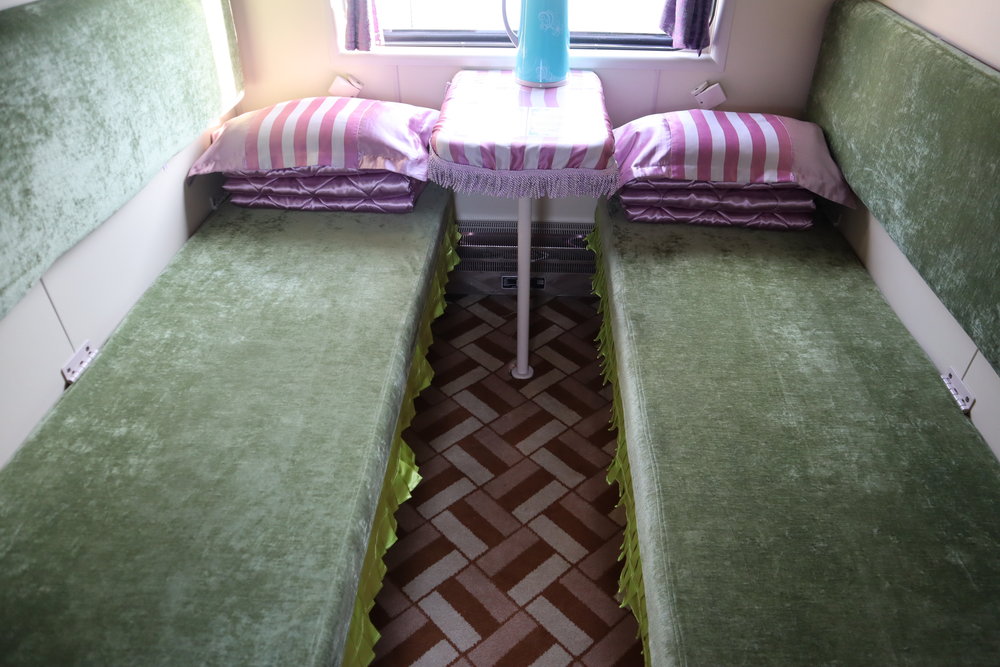
Trans-Mongolian Railway, Second Class
The Long Way Home
There’s a break-of-gauge between the two rail systems at the Mongolia–China border, and each train carriage needs to have its wheels changed. We therefore have the pleasure of a five-hour stop in Erlian, the Chinese border town in the province of Inner Mongolia. It’s a huge relief to be able to speak the local language once again.
Our train gets moving again at 2am, and we wake up the next morning to the final stretch of our Trans-Siberian Railway trip. The scenery outside gradually grows familiar as we pull into Beijing Railway Station – but it doesn’t quite feel real.
Yes, we were in Red Square last week, and we’re in Tiananmen Square today. But I can’t help but feel as though the notion that I’ve taken the train all the way across this enormous landmass can’t possibly be true, even though I’ve just lived through it.
To be honest, I don’t think the sheer magnitude of what we’ve accomplished will be fully grasped until we look back on it many years later. I have no doubt how tremendously rewarding it will be to pore over the globe on my desk and trace our memories of the Trans-Siberian Railway, and that reason alone will be worth the 12 gruelling days we spent on the road.
Conclusion
There’s a reason the Trans-Siberian Railway captures the imaginations of so many travellers every year. An eclectic mix of grit, romanticism, and old-school charm, it’s a unique way to get in touch with your inner adventurer while exploring a part of the world that’s often overlooked. While I’ve given you a rundown of my initial reflections, I still have many more to digest as I look back on my trip in the future, and I look forward to writing the complete trip report and bringing you every detail from this immensely rewarding journey.



















The most amazing thing about your trip is how anyone can “ hold it in “ for days at a time!
When you arrived at “proper facilities”, it must have been a heavenly experience indeed.
You have no idea 😉 Unfortunately I couldn’t keep up my streak and ended up having to go on the 4th train ride, just 10 minutes short of arriving in Beijing.
Great post Ricky! Curious to know how the immigration experience was like in Mongolia and China.
From Russia to Mongolia, we stayed in our compartments while the immigration and customs officers came on board to inspect our documents.
Leaving Mongolia was a similar experience. However, upon entering China, we all had to get off the train and go through an immigration facility (presumably because of the break-of-gauge and the change of bogies).
I’ll cover this in more detail during my in-depth reviews.